Essential PH-1 review: A beautiful blank slate
There's a lot to love about the PH-1, but camera buffs should look elsewhere.

Andy Rubin was disillusioned. He helped build the Android operating system. He watched as Google acquired the company, and he steered development on the mobile OS for years after that. And somewhere along the way, he grew a little weary of how the smartphone market worked.
To hear him tell it, the mobile industry prioritized iteration over innovation, to the point where it centered itself around only two companies: Apple and Samsung. Convinced that Apple's premium phone business model would work for a startup, Rubin set about building his own phone, and here we are. That startup, Essential, offers its new PH-1 as a remedy to the industry's ills. It's a premium smartphone with an impeccable pedigree that embodies progress and choice and openness. That was the idea, anyway.
Here's the thing about lofty goals though: You're almost never going to achieve them in one shot. And really, that's the Essential PH-1 in a nutshell. It's an exceptionally crafted device and a stunning first effort from a company that didn't exist 18 months ago. While the PH-1 stands as a testament to Rubin's vision, a few shortcomings keep it from being as truly great as promised.
Hardware
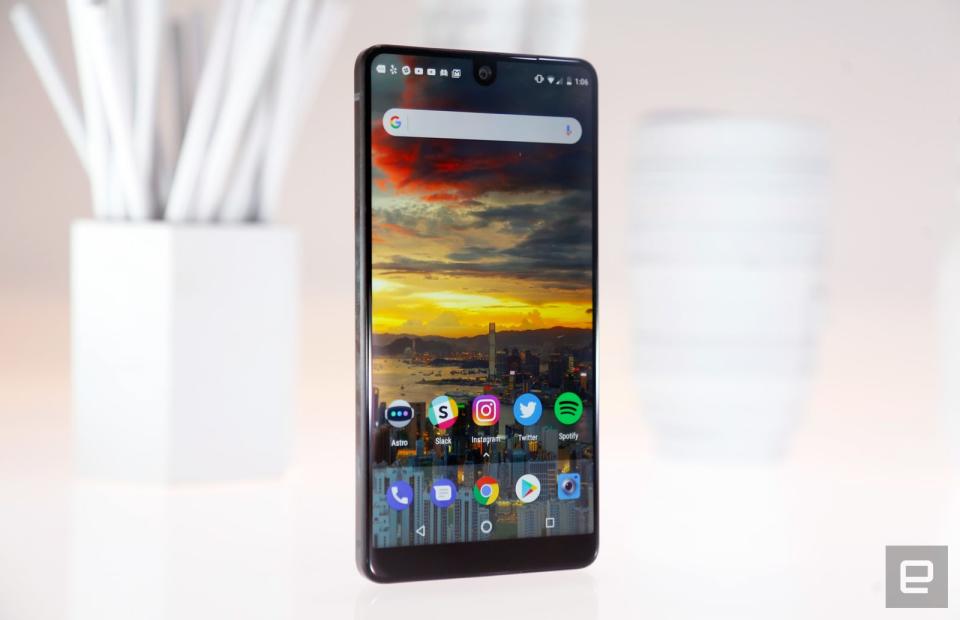
I've been testing the black PH-1 ($699), and it looks more like a blank slate than any phone I've tested in a while. There are no logos on the phone, no branding, no FCC labels or capacitive buttons (though the company's engineers did consider them). Peer closely enough around the front-facing camera and you'll spot a tiny cutout for the earpiece and an even tinier notification LED. Some will find the aesthetic a little too nondescript, but others (like me) will enjoy the intentional starkness. That minimalism gets disrupted when you turn the phone over. There you'll find an LED flash, a 13-megapixel dual camera, a fingerprint sensor and two tiny, metallic spots.
This is Essential's (much smaller) take on the Motorola's Mod connector for its modular smartphone add-ons. Accessories, like a 360 camera I haven't been able to test yet, magnetically attach to that spot and can transfer power and data into and out of the phone. It might seem a little awkward to snap things onto a phone's corner, but Essential made the choice deliberately.
By putting the connector on a corner, the company is theoretically able to change the way future devices look without necessarily giving up the option of backward compatibility. Consider the most recent Moto Z phones: Motorola couldn't change the design much, because its Mods have to sit flush against the phone's backs. Essential's decision was a savvy one, but we'll soon see how many companies are willing to invest in a startup's ecosystem of accessories.
The PH-1 also feels dense, in a reassuring sort of way. Part of that is thanks to what the phone is made of. A polished titanium frame forms the PH-1's skeleton, and its back is made of a shiny ceramic that has been pretty good at shrugging off scratches and dents. (It's starting to show nicks now though.) I was worried that the PH-1 would exhibit Xiaomi Mi Mix levels of fragility, but so far, so good. The phone's density is also due to how tightly packed all of its components are under that shiny surface. Jason Keats, Essential's head of product architecture, said in an interview that there's basically no extra space at all inside the chassis. Pending a glorious iFixit teardown, I'm inclined to believe him.
What's inside the phone is a little more prosaic. Like just about every other flagship phone this year, the Essential uses one of Qualcomm's Snapdragon 835 chipsets, paired with 4GB of RAM and an Adreno 540 GPU. More importantly, every Essential comes with 128GB of internal storage, which is crucial since there's no microSD slot. That's not the only notable omission here: There's no headphone jack, just a USB-C port wedged in between a speaker and the SIM tray. There's no water resistance here either, for reasons Essential has never entirely explained. These omissions certainly aren't dealbreakers, but they're still somewhat disappointing.
Display and sound
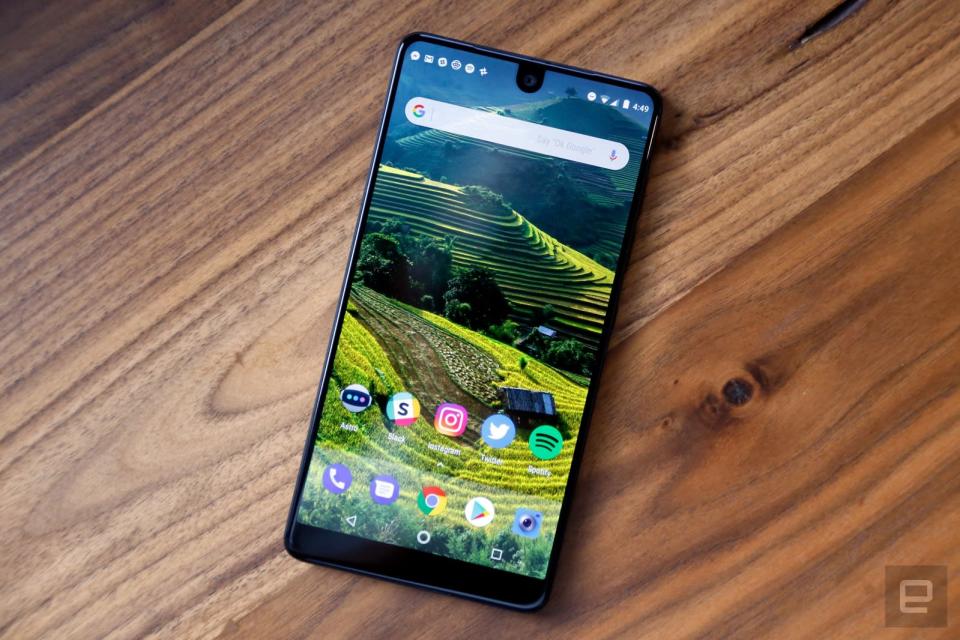
While the phone's design is intentionally subtle, that 5.7-inch Quad HD screen definitely isn't. The PH-1's defining feature is how its LCD display stretches almost completely across the phone's face, leaving just a few millimeters of black chin beneath the panel. It's stunning. When the screen is off, we're left with an obsidian slab; when it's on, it feels like something out of the future. Well, the near future, anyway. We've seen phones with expansive displays before, but there's something sumptuous and thrilling about a phone that's basically all screen. Arguably more impressive is how a divot has been cut out of the screen to accommodate the 8-megapixel front-facing camera. It sounds weird in theory, but since Android's notification bar fills in from the sides, the camera never actually gets in the way.
Yes, it's almost impossible at first not to gawk at the PH-1's screen. The gap between the panel and the glass that covers it may as well not exist, so viewing angles are excellent. Colors are clean and vivid, though they lack the telltale punchiness of AMOLED screens (most likely due to cost). As technically impressive as it is, the screen does fall short in a few ways.
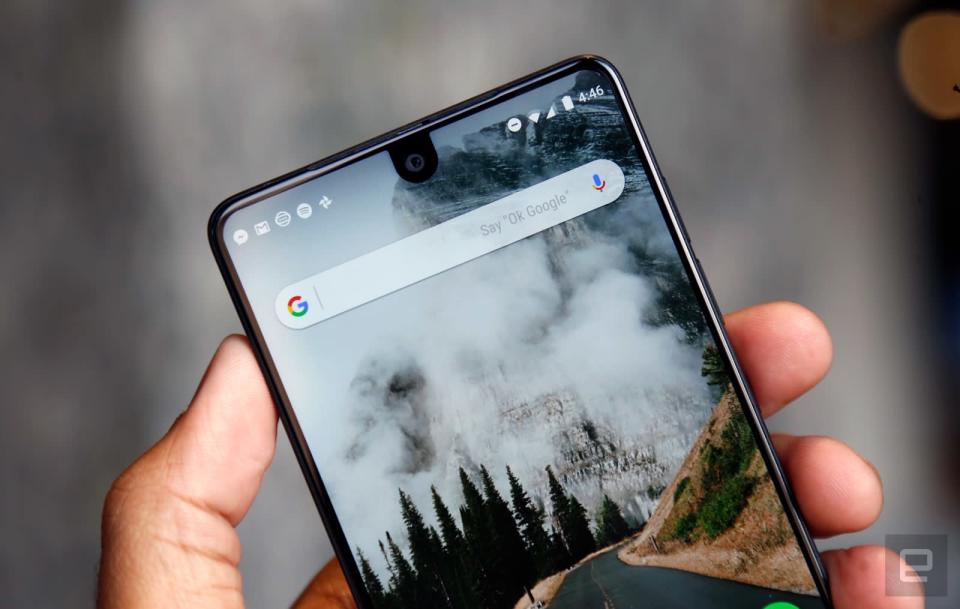
For one, I wish it were a little brighter: It's perfectly readable in broad daylight, but phones like the Galaxy S8 and iPhone 7 are brighter and more clearly legible under the sun. It's also a bummer to come across apps that don't take full advantage of that extra screen space. The phone's dialer, Chrome, Twitter, Spotify and more are all bounded on the top edge by a black bar, robbing you of the visual impact that comes with seeing, say, a Google map that stretches all the way across the phone. Unfortunately, this was the case with most of the apps I've tested this past week.
Other apps are prone to different issues. Spotify, for instance, has a lot of extra space below the notification bar, pushing all the actual content down a little more than expected. This issue has been less common, but it's still mildly annoying whenever I come across it. Considering how niche the Essential phone is right now, it's unclear when or if developers will update their apps to accommodate this eye-catching screen.
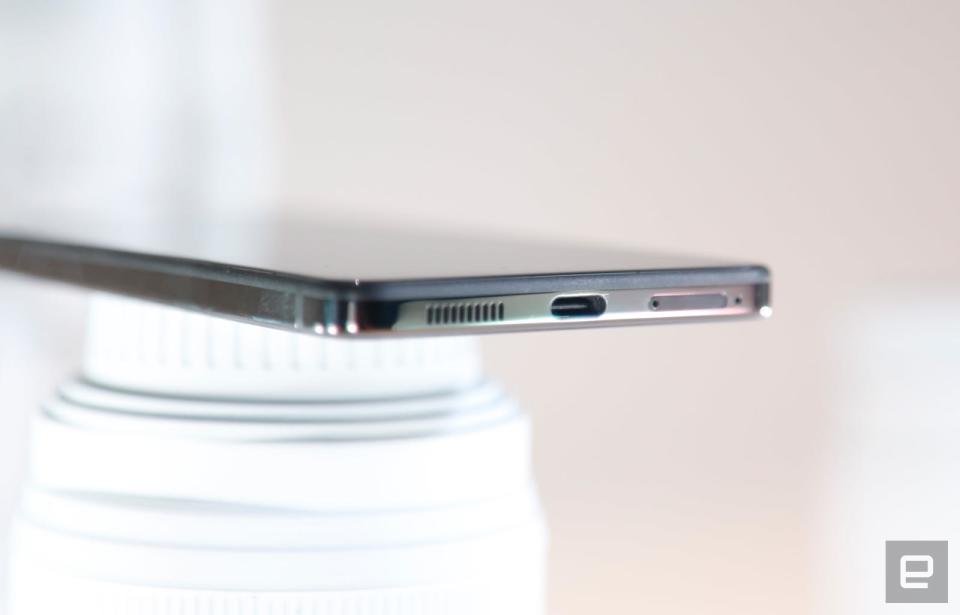
Meanwhile, the Essential's single speaker mostly just gets the job done. It's louder than I expected, but audio comes out sounding pretty thin and it's easy to accidentally cover the grille with your finger when holding the phone sideways. If you spend most of your day listening to audiobooks, podcasts or music that doesn't feature prominent bass, the speaker shouldn't bother you much. As always, though, you're better off using a pair of headphones, which in this case means having to rely on an included USB-C adapter. I had no issues with audio quality through the adapter, and its short, braided cable gave me hope that it would survive a long-term stay in the minefield that is my backpack. I was also a little concerned that such a small earpiece wouldn't sound good, but it made for pleasant for voice calls; no one on the other end had any complaints about the audio quality either.
Software
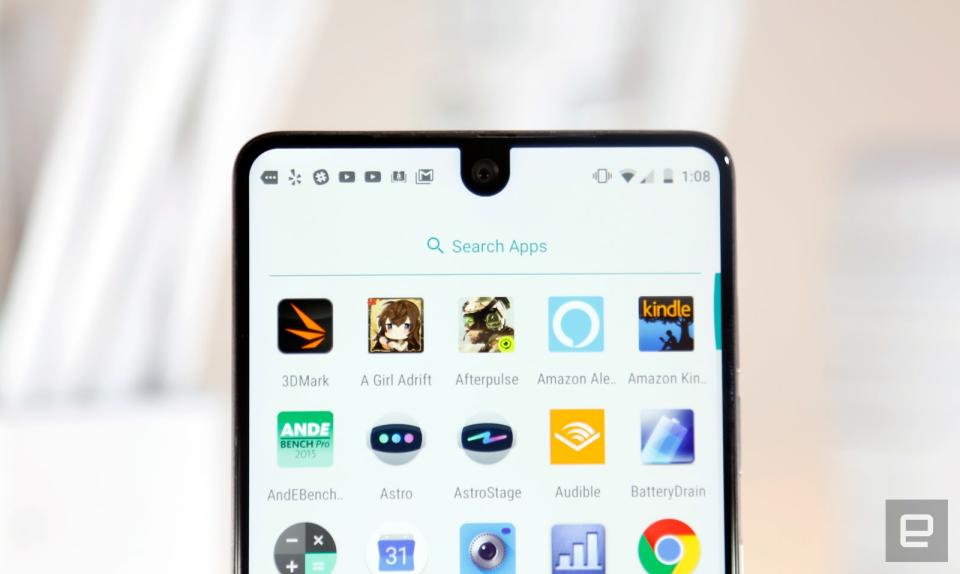
And the blank slate theme continues. The PH-1 runs a clean, mostly untouched version of Android 7.1.1. I've said that about other phones before, most recently the Moto Z2 Force, but Essential takes cleanliness to a different level. I've only spotted a handful of changes here. For starters, the typical Android notification bar is thicker than usual, because it has to clear the camera sitting right in the middle of it. There's also an option in the settings to discreetly send usage and diagnostic data back to Essential so the company can smooth out potential performance issues. Really, the biggest change to bare-bones Android is the inclusion of a custom camera app, which we'll get to in a little bit.
The situation is a little different for Sprint customers: Upon activation, the My Sprint and Tidal apps are automatically installed. Considering how overzealous some carriers are when it comes to preloading apps to fulfill business agreements, Sprint's minimal overreach feels downright refreshing. The rest is just Nougat as we all know it, and Essential has pledged to deliver Android updates to PH-1s in the wild for two years and security updates for three years.
Now, as much as I love stock Android, I have to wonder if it's enough to whet the average consumer's appetite for functionality. After all, there's a reason Google offers more than just stock Android on its flagship Pixel phones: It's all in the name of helping users more easily accomplish the things they want to do. I respect Essential's devotion to openness and cleanliness, but there's a way to deliver subtle, powerful changes without completely rewriting the playbook. In any case, I'm sure the decision to deliver one of the purest Android experiences out there won't hurt the startup's chances too much. If anything, it offers an extra dose of geek cachet.
Camera
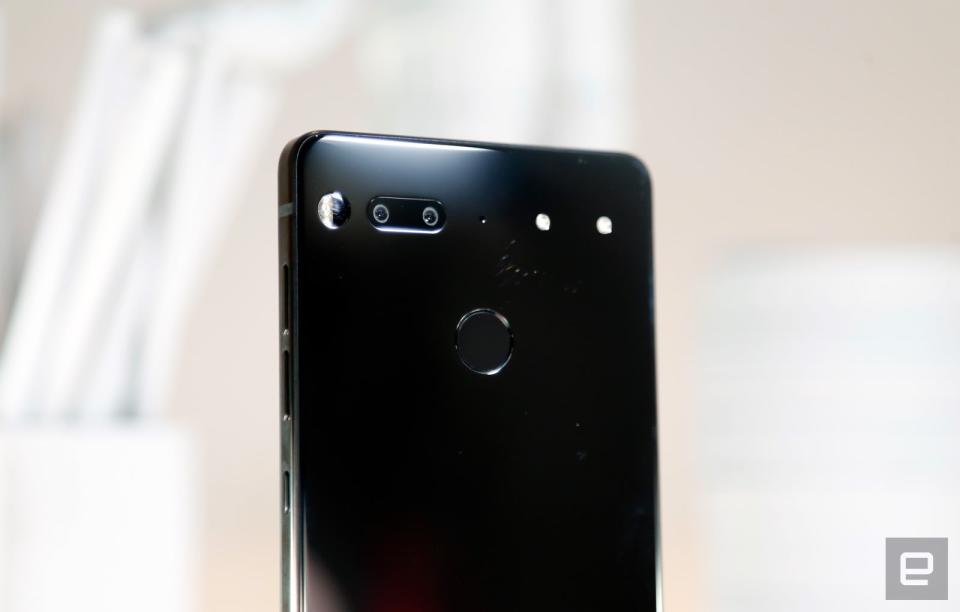
Like many other top-tier smartphones, the Essential packs a dual-camera setup. Unlike a lot of other top-tier smartphones, however, the Essential blends one 13-megapixel color sensor with one 13-megapixel monochrome sensor, as opposed to, say, a wide-angle and telephoto camera. The idea is simple: When shooting normally, color information from one sensor is combined with the extra detail capture from the black-and-white camera to produce photos that embody the best of both worlds. When there's good light to work with, the results are decently impressive: Colors are a bit more subdued than with rival cameras but still quite nice, and there's a decent amount of detail to be found. Overall, devices like the Galaxy S8 and last year's Google Pixels did a better job, but the Essential was never too far behind.
Now, here's where things get a little tricky. Since I received the phone last week, Essential has pushed out two -- two! -- updates, both heavily focused on improving the camera. Before any of the updates went live, the PH-1 was frankly awful in low light; you'd find lots of fuzzy edges and an unreasonable amount of grain and discoloration, even when shooting in locales that weren't that dim. After multiple updates, the performance has leveled off to the point where the Essential is mostly usable in low light (though it helps to keep your expectations low).
Since there's no image stabilization here, you should still expect to see lots of indistinct edges in the dark, but better image processing has reduced the grain you'll see to manageable levels. Compared to before, this is a huge improvement. Compared to the rest of this year's flagship smartphones, the Essential phone's camera still disappoints. The 8 megapixel front-facing camera works well -- at least, most of my selfies were nicely exposed with accurate colors.
No matter which camera you're using, shooting with the Essential is dead simple. You can shoot a normal photo in auto mode. You can shoot a black-and-white photo with Mono mode. You can shoot a (pretty ugly) slow-motion video. You can take a selfie, and you can record a video. That's it. While other smartphone cameras pack loads of features and multiple camera modes, the Essential's camera experience is among the most bare bones I've ever seen. For some people, that will be fine: There's nothing wrong with pointing and shooting. Anyone looking for more nuance and control should look elsewhere. All you can do here is toggle the flash and HDR modes, set a timer, and change the quality of the video you want to shoot.
This wouldn't be an issue if the Essential took better photos from the get-go, but here we are. I should also point out that, while improved, there's still some lag when switching between the color and monochrome cameras, and I've taken one or two photos over the course of the week that appear to have never been saved to my camera roll. In both cases, I launched the camera by double-tapping the home button, but I still can't figure out what happened to them.
Performance and battery life
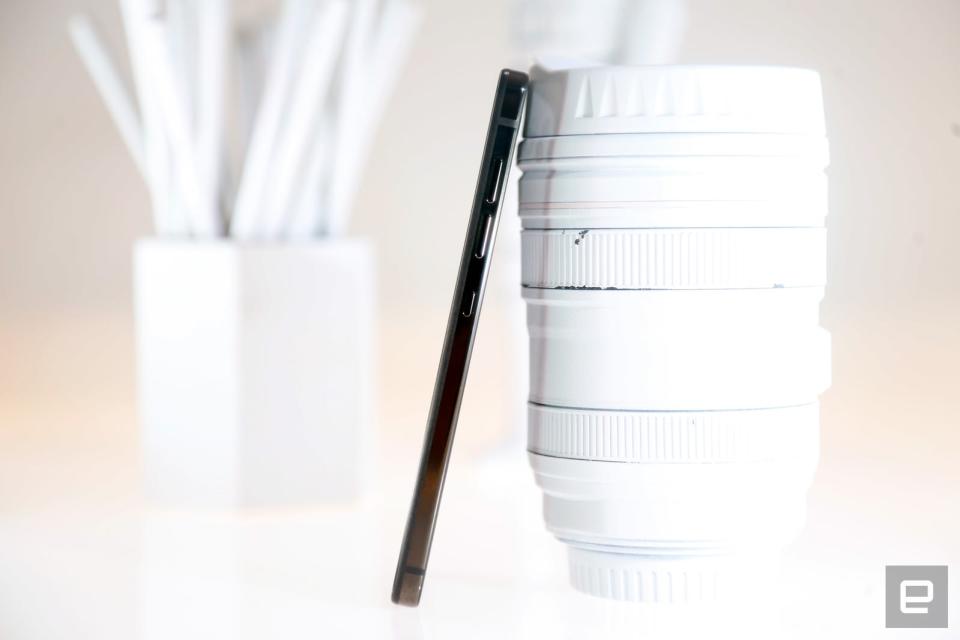
As already mentioned, the Essential PH-1 packs an octa-core Snapdragon 835, 4GB of RAM and a dearth of obnoxious add-on software. Is it any surprise that it runs incredibly smoothly? General navigation feels pleasantly fast -- as fast as the Pixels and the S8s, anyway -- and frenzied multitasking proved to be no problem either. Visually intense games like Afterpulse ran with no problems as well; frame rates were consistently high, and lag essentially didn't exist. Impressive, certainly, but maybe not a surprise: This consistently high level of performance is table stakes for a modern $700 smartphone. Said differently, something would have been very wrong if Essential hadn't been able to deliver.
If the phone's performance wasn't surprising, its battery life certainly was. The phone seemed to struggle through our first full workday together, but that was just a peculiar one-off. After that first day, I've been able to use the PH-1 for a full day without the need for a recharge. After nights when I forgot to charge it, I still had between 20 and 25 percent at my disposal -- that was more than enough to keep me entertained during my morning commute to the office. You can expect more battery drain in areas where cell coverage isn't great, a problem I've run into with Sprint more than other carriers. In places where the phone had trouble locking on to a signal, the battery barely lasted for a day. Long story short, most people will be pleased with the phone's power consumption, but folks living out in the country may experience a little more trouble.
The competition
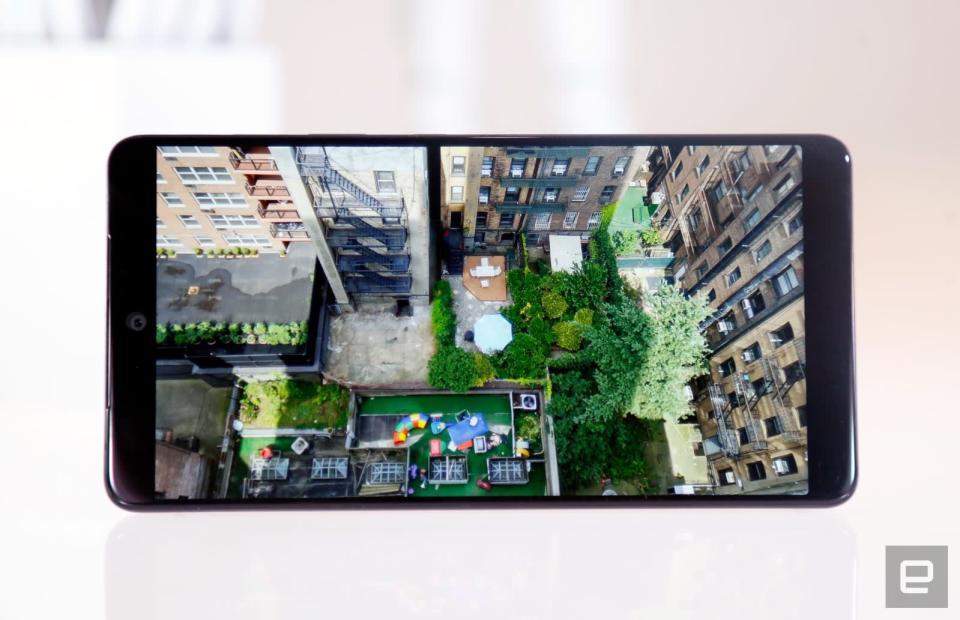
Essential has made more progress than most in eliminating bezels from phone bodies, but it's definitely not alone. Samsung's Galaxy S8 and S8 Plus remain two of the best smartphones out there, and they pair skimpy bezels with lots of horsepower and some truly excellent displays. Their aesthetics couldn't be any more different than the Essential's, but Samsung's design work has been impeccable: While the PH-1 feels dense and masculine, the S8s feel friendlier and more welcoming. This is obviously a matter of taste, but unless you absolutely insist on pure Android, you can't go wrong with either of these options.
LG's G6 is another notable competitor, if only because it takes the exact opposite approach to dual cameras as the Essential. It's not perfect, but the combination of normal and wide-angle 13-megapixel cameras seems infinitely more useful -- not to mention more fun -- than Essential's implementation. Beyond that, the G6 brings slightly more modest levels of performance and battery life, but some will find the trade-off worth it just to have a more flexible camera.
Wrap-up
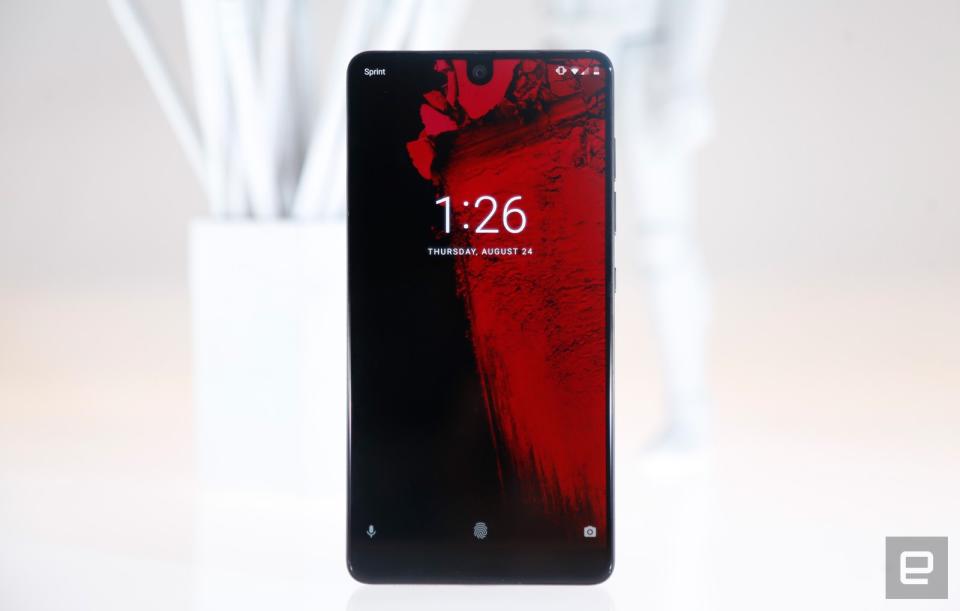
I had such high hopes for the Essential phone that there's almost no way the PH-1 could have lived up to them. This isn't just a reflection of my own unreasonable internal hype though; as truly impressive as the PH-1 can be, it lags behind the competition in some areas. That's the difficult part about offering people a blank slate of a smartphone. Sure, it can assume whatever role the user wants it to. Since it doesn't offer many flashy features of its own, though, the phone has to get all the basics right. In its current state, the PH-1 doesn't.
Still, it's heartening to see Essential build a phone that otherwise gets so much right on its first attempt. Andy Rubin seems to hold the usual conventions of smartphone making in contempt, so who knows when we'll see another Essential phone. That's too bad. After such an impressive first outing, I honestly can't wait to see his team try again.





























































